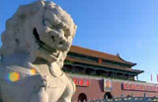Chicken-blood jade dealers feather nests
Updated: 2015-04-24 07:31
By Huo Yan andWang Xiaodong(China Daily)
|
|||||||||||
Traders in the small township of Sanmen are cashing in on a recently discovered rare natural resource that's boosting incomes and changing lives. Huo Yan and Wang Xiaodong report from Guilin in the Guangxi Zhuang autonomous region.
Like many of his fellow villagers in the mountain township of Sanmen, Zhou Yunyao used to migrate to bigger cities to undertake a range of jobs, such as vehicle maintenance, to raise his standard of living.
That's no longer the case, though. Fortune smiled on Zhou in 2012, when he returned to his hometown in the Guangxi Zhuang autonomous region from nearby Guilin city and opened a shop selling souvenirs made from chicken-blood jade, a type of stone that's predominantly red in color and was only discovered in the area in recent years.
In the 15-square-meter shop, a number of differently sized and shaped rocks containing the rare resource and the souvenirs made from it, such as seal stamps, bracelets and cups, are displayed on glass shelves and tables.
Zhou said the shop brings him 300,000 yuan ($48,000) a year, about six times more than he earned as a mechanic. He gets his raw materials from a friend who owns a mining company that excavates jade in the nearby mountains. "The jade business brings high profits," he said.
Sanmen, a town with a population of 15,000 that's administered by Longsheng county in Guilin, is the region's biggest jade-production area. Traditionally, the residents have relied on farming for their livelihoods, but in recent years they have been taking advantage of the local resources to eradicate poverty and fuel their aspirations of wealth.
About one-third of the city's residents are engaged in the excavation, processing or selling of chicken-blood jade, and business related to the stone accounts for 50 percent of the town's annual GDP, according to the Guilin Chicken-blood Jade Association.
A relative newcomer
Compared with other famous Chinese jade that has been excavated for thousands of years, such as those from Hotan in the Xinjiang Uygur autonomous region, and Anyang in Henan province, chicken-blood jade from Gui-lin is a relative newcomer. It wasn't until 2006, when the Gemological Association of China conducted tests and officially recognized the stone, that it began to gain popularity outside its home area.
Previously, the jade had been regarded as a type of chicken-blood stone, which has been excavated in parts of China, including Sanmen, for hundreds of years. However, Guilin's chicken-blood jade has a number of unusual characteristics, such as a high degree of hardness and great resistance to corrosive chemicals such as acids, that distinguish it from the inferior chicken-blood stone, according to Wu Guozhong, a former vice-president of the GAC.
Storeowner Zhou said the price of the stone began to soar in 2011, turning what had been seen as an inferior material into a valuable commodity. "Before 2006 it was disposed of as waste material," he said.
Li Sisheng, chairman of the Guilin Guanshitang Chicken-blood Jade Museum in Longsheng county, said: "In 2007, the price of the raw jade material was about 1,600 yuan ($258) a metric ton, but it's now 50,000 a ton."
She Qiuming, who owns a store in Guilin, said she has a piece of rare chicken-blood jade about 4 meters long and weighing 18 tons that was valued at 300 million yuan by gemological experts in February.
During the ninth China-ASEAN Expo held in 2012 in Nanning, the capital of Guangxi, souvenirs made from chicken-blood jade were presented as official gifts to attendees from Southeast Asian countries.
Locally owned stores that sell chicken-blood jade dominate both sides of Sanmen's biggest road. Stones of various shapes and sizes, some as tall as 2 meters, that are expected to produce chicken-blood jade after polishing stand at the doors of most of the shops, attracting the eyes of passers-by.
"At least 30 households in the town have become (yuan) millionaires in the past few years through the chicken-blood jade business," Zhou said.
During a visit to the fledgling Guilin Guanshitang Blood-jade Museum, the city's first museum dedicated to the material, in July, Guilin's Party chief Zhao Leqin pledged support for the development of jade-related arts businesses, arguing that they would further enhance Guilin's status as a destination for tourists from around the world.
"We've collected a number of sculptures made from the very best chicken-blood jade," Li Sisheng, chairman of the museum and an avid jade collector, said. "We will open the museum to the public in May, when the building work has finished."
Construction of the facility, which will occupy an area of about 6,700 square meters, started in 2012 with support from the local government, Li said. By the end of January, the museum had become home to 260 sculptures made from the local jade, and more than 200 pieces of stone that contain the rare mineral, he said. Some of the exhibits came from a mining site that Li's company - Zhaohui Stone Material Co, a miner in Sanmen that has been operating since 2010 - has excavated, while others were purchased from individual collectors, he said.
"Although our company excavates nearly 10,000 tons of minerals every year, we only get about 30 tons of top-quality jade," he said. "We will not sell a single piece, though - we will collect them in the museum so everyone can enjoy their beauty."
A government-supported industrial zone has been established in Sanmen, and is expected to facilitate related industries, including manufacturing, sales and art exhibitions. The township will also hold regular cultural festivals to display and promote the local culture.
While the skyrocketing price of chicken-blood jade is attracting a large number of investors, they should be wary of the risks, according to Li. "Excavating the jade is sometimes like gambling. Although Sanmen has abundant resources, it's not easy to find materials that are rich in chicken-blood jade because it's usually hidden in rocks that appear to be no different from ordinary rocks," he said. "Sometimes we've excavated hundreds of tons of stone without finding even the smallest piece of jade."
Rising costs
Moreover, the cost of excavation permits issued by the local government has risen rapidly, Li said. According to the Guilin Chicken-blood Stone Association, two excavation permits for chicken-blood jade, each with a benchmark price of 3 million yuan, sold for 28 million yuan and 38 million yuan at a 2013 auction organized by the local government.
Another downside is that the inclement weather in the sub-tropical, mountainous region means mining companies can only operate for five months a year at most because their sites are mostly located deep in the mountains.
"The market price of the jade is affected by many factors," Li said. He added that the intensification of the central government's anti-corruption campaign in the past two years has affected the popularity of the precious stone. Media reports concerning corrupt officials often note that they were given pieces of chicken-blood jade by businesspeople as bribes.
The rising price has also attracted a large number of illegal miners, most of whom are villagers who live near the mines, he said.
Lin Ruiming, a security manager at a mining company in Sanmen, said illegal mining and theft still exist in the mining areas despite regular patrols conducted by a 24-member law enforcement team established by the local government.
"They (the illegal miners) have advanced tools, such battery-powered hammers that can be used anywhere," he said, adding that his patrols often encounter villagers in the act of stealing the company's minerals and are forced to drive them away.
"The patrols sent by the government can't keep them out altogether," he said. "The thieves and the patrols are just playing games of hide and seek."
Raising the bar
According to Meng Shuke, vice-president of the Longsheng Chicken-blood Jade Association, more than 200 enterprises in Longsheng are involved in the industry, but most of them are small and at the lower end of the industrial chain. Moreover, poor local polishing techniques mean that most of the chicken-blood jade sold in the county is offloaded as raw materials or as primary products such as seal stamps, which only bring low profits, he said.
"We plan to invite professional polishers from other provinces to hold training sessions for the locals to help them improve their skills and raise the quality of their jade products," he added.
She, the storeowner from Guilin, said Longsheng lacks a jade-processing tradition, which means he has to offer high wages to attract polishers from other provinces, such as Fujian, to process the raw material. "At present, most of the products we sell are just rough cuts," he said.
Meng said the association plans to work with the local government to establish a 20,000-sqm market in Longsheng that will open in early 2017 and will accommodate all the private jade businesses in the county.
"Our aim is that Longshen's chicken-blood jade industry will enjoy an orderly and regulated development and rise to the high end of the industrial chain," he said.
Contact the writers at huoyan@chinadaily.com.cn and wangxiaodong@chinadaily.com.cn
|
A selection of artworks made from chicken-blood jade. Excavation of the stone is changing the lives and fortunes of residents of Sanmen in the Guangxi Zhuang autonomous region. Photos by Huo Yan / China Daily |
|
A worker uses a machine to cut rock containing pieces of chicken-blood jade. |
|
Meng Shuke, vice-president of the Longsheng Chicken-blood Jade Association, displays one of the pieces in his collection of chicken-blood jade. |

(China Daily 04/24/2015 page6)
Today's Top News
China and Russia to start search for Soviet soldiers' remains
Kim likely to visit Russia in May for war victory ceremony
Specialists discuss hot topics in China-EEC relations
Europe gaining importance in China's foreign investment
EU leaders to restore rescue operations after migrant boat disaster
EU, Cuba to hold political dialogue meeting in June
Britain celebrates Queen Elizabeth II 's 89th birthday
Cuban FM visits France over relations
Hot Topics
Lunar probe , China growth forecasts, Emission rules get tougher, China seen through 'colored lens', International board,
Editor's Picks

|

|

|

|

|

|









